This has been one busy academic year for me, and the non-stop news cycle has not helped matters. As is painfully obvious by my decreased production of blog posts. Don’t worry — I’m not going anywhere, and I will make up some of the difference in August when I visit Japan for the first time, in time for the Hiroshima bombing anniversary. Below is a description of one of the projects that has been occupying my time these last many months.
I am extremely pleased to be able to announce one bit of “secret” work that is finally going public: a sizable grant that I am involved with has been chosen for funding by the Carnegie Corporation of New York. It is one of 11 projects funded by a joint effort from the Carnegie Corporation of New York and the John D. and Catherine T. MacArthur Foundation “to support projects aimed at reducing nuclear risk through innovative and solutions-oriented approaches.”
The project is called “Reinventing Civil Defense,” and it’s been fun to tell people about the proposal and watch their eyes get very wide at the name. That’s intentional. When CCNY and MacArthur put out their call for proposals, they said they wanted new ideas, things from outside the box. So we decided to try and go pretty big in that direction.
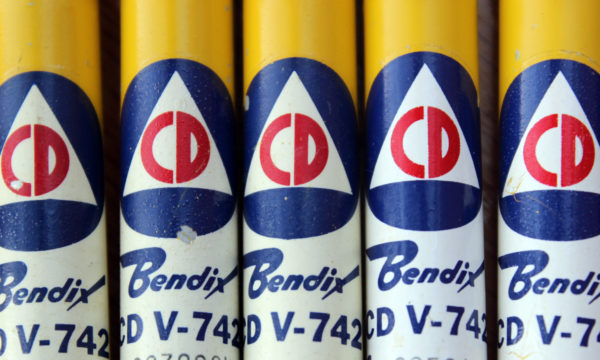
Bendix dosimeters, for tracking personal radiation exposure. The two Civil Defense photos accompanying this post were all taken by me in order to illustrate the Reinventing Civil Defense website, from various Cold War bits and pieces I have lying around the apartment. I wanted something that nodded at the Civil Defense imagery we are familiar with, but also indicated that this was going to be a new take on it.
The “we” here is our team of co-PIs at the Stevens Institute of Technology, myself, Kristyn Karl, and Julie Pullen. Together, we created and will run the Reinventing Civil Defense project, with key contributions from Ed Friedman. Kristyn Karl is a political psychologist who works across the hall from me, in the College of Arts and Letters, and whose work involves studying how people evaluate risk, especially in response to communications about it. She has researched the ways in which people evaluate different types of reporting about terrorism, and how that impacts their emotional responses and subsequent policy support (or lack thereof). Julie Pullen is an associate professor of oceanography and meteorology who I have known since I came to Stevens, who works in the School of Engineering and Science, who has done a lot of research into port and maritime security in the New York City area, and has studied technical issues relating to nuclear terrorism. Ed Friedman is an emeritus professor of physics, and one of the reasons I am at Stevens in the first place: it was Ed whose initial interest in my work brought me here to give a talk, at which point I not only realized where Hoboken was (I grew up on the West Coast, so my East Coast geography was pretty poor), but learned there was a job search going on in my field. Ed has had one of those lives that looks so jam-packed with interesting and important work (as a sample, he worked in Afghanistan for many years before the Soviet-Afghan war, teaching at the engineering school in Kabul) that no matter what one accomplishes, one feels like one has done almost nothing, but he is a generous and concerned scholar who is deeply interested in matters relating to nuclear weapons and terrorism.
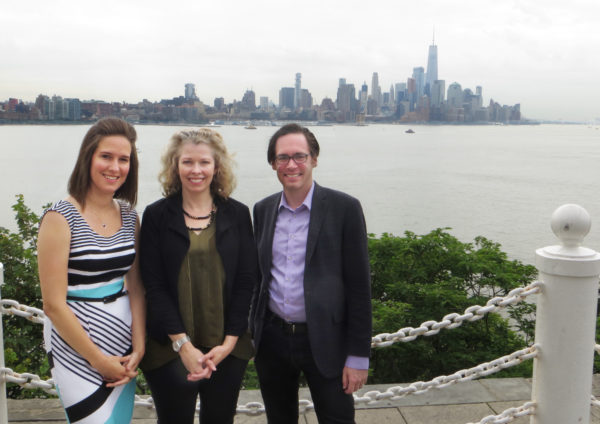
Kristyn Karl, Julie Pullen, myself (Alex Wellerstein), taking a somewhat awkward picture (the weather was not entirely behaving) at Castle Point Lookout at the Stevens Institute of Technology.
Ever since I took the job at Stevens, Ed, Julie, and I had been talking about ways in which we could leverage the essential principles and success behind something like the NUKEMAP in a way that would have even wider impact. This led to a lot of discussions about how digital tools might produce different ways to think about science and risk communication, beyond the more traditionally “didactic” modes associated with formal education. Study after study has shown that didactic, lecturing approaches to getting information across only works in a very limited way — and as a teacher, it is clear that it is extremely inefficient even within the confines of a formal educational setting (e.g., people who are taking out massive loans with the idea of getting an education). If your goal is to affect a much broader spectrum of people, about pressing policy issues, you have to find another way. Kristyn’s work on science communication and risk perception was a natural fit with these interests, and so we brought her into these discussions not long after she was hired at Stevens.
Around the time of the Carnegie/MacArthur request for proposals (October 2016), I had been thinking about Civil Defense quite a lot. Ed and I were co-teaching a seminar on nuclear policy topics, and had dedicated a week to the subject, having the students (and ourselves) read various Civil Defense texts and critiques from a few different “eras” of US Civil Defense work. I had looked into a lot of these issues when designing the codes for the NUKEMAP (which are still being worked on, as an aside; there will be some interesting new features added in the very near future), and it seemed like there was a lot of discussion of this issue “in the air” then (and even more since). And, when I lived in DC, I had some very productive discussions with my friend Ed Geist (now at RAND Corporation; we recently co-authored an article on the Soviet H-bomb project in Physics Today), who wrote his dissertation on US and Soviet Civil Defense policies. The general feeling I had about Civil Defense was, some of it was nonsense (the quick evacuation of big urban centers always seemed infeasible), some of it certainly expressed a blasé approach to mass destruction, but it was not as crazy as the anti-nuclear activists often made it out to be, and indeed many of its core approaches have been integrated into preparation for other kinds of major hazards (Civil Defense eventually morphed into Emergency Management, which takes a somewhat different approach with regards to engaging the general public). It seemed highly politicized and polarized, by both the anti-nuclear and pro-nuclear folks (having Edward Teller be ones of its chief advocates was not going to “bridge that gap,” either).
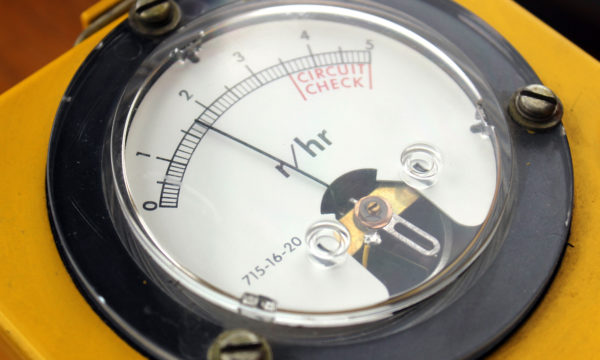
A Victoreen radiation detector. The units of this are pretty high — it’s not meant to budge unless you’re in a bit of trouble. To get it at something other than a zero read I did a circuit check and let it work its way back down again.
So when I was thinking about the Carnegie/MacArthur request, suddenly this idea flashed in my brain (in the way of all of my ideas, both good and bad, it just appeared all at once): what if Civil Defense wasn’t politicized and wasn’t dumb? What if you approached it in a truly even-handed, non-partisan way? What if you thought very seriously about the deficiencies of Cold War Civil Defense, notably its approach to messaging, and thought about what that would look like in the early-21st century, where the more probable nuclear threat is not the multi-megaton, thousands-of-targets exchange of the late-20th century, but single-use detonations of terrorists or so-called “rogue states”? What would that look like? What would it look like if your approach was not the government producing lectures and pamphlets (because American trust in government has notably plummeted from the late 1960s onward), but non-governmental organizations producing digital products and tools?
And, of course, what would be gained from this approach? Potentially much, for people of all political stripes. Those who believe that Civil Defense should be embraced because it would lessen the consequences of a nuclear detonation (and if risk is probability times consequences, then you are reducing the risk by doing this) would be pleased by the reduction of preventable casualties that might come with such an effort. Those who are more concerned with galvanizing public opinion about nuclear weapons would, perhaps, be pleased that the lived experience of nuclear risk — nuclear salience — would be increased, in a way that it has not been since the height of the Cold War. It is my belief, and I will have a piece about this coming out pretty soon, that the elimination of Cold War Civil Defense education ironically allowed nuclear weapons to pass out of public awareness, which was certainly not what the people opposed to Civil Defense were interested in.
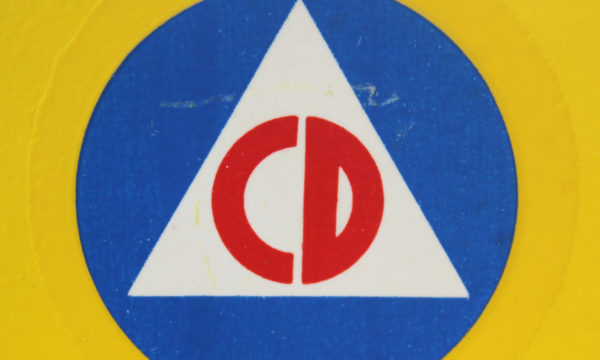
The logo of the Federal Civil Defense Administration, from the side of the aforementioned Victoreen detector.
And on top of all that, this kind of project would create an opportunity to explore new kinds of risk communication and messaging (with new media, like Virtual Reality), and its effectiveness (which someone like Kristyn designs experiments to test). So at its most ambitious, this project is about potentially altering American nuclear culture (and maybe non-American, ideally, but you’ve got to start somewhere), and potentially facilitating the means to save thousands of preventable casualties in the event of a nuclear detonation. And even if those very lofty goals are not possible to be achieved (changing culture is obviously a very difficult thing!), it could still be a catalyst for a lot of interesting prototypes. Much of our budget is earmarked for sub-awards that will generate “deliverables” meant to be focal points for these conversations about nuclear salience (think VR apps, games, graphic novels, along with more traditional output like studies and whitepapers and reports), and two workshops where we will hash over these questions and come up with some recommendations (the workshops are invitation-only, but if you are interested please get in touch and we’ll see what we can accommodate within our space and budget).
Ed, Julie, Kristyn, and I bounced this idea around, to great effect. The germ evolved into a full-fledged proposal. We also decided that we would need some kind of Advisory Committee to help make sure that we weren’t barking up the wrong tree, and to give us perspectives that a bunch of engineering-school professors might not have. You can see the list of the Advisory Committee members on our project website — I’m pretty amazed at the people we were able to convince to agree to be part of this project, and just getting them all together in a room, talking about this issue, will no doubt be an interesting conversation.
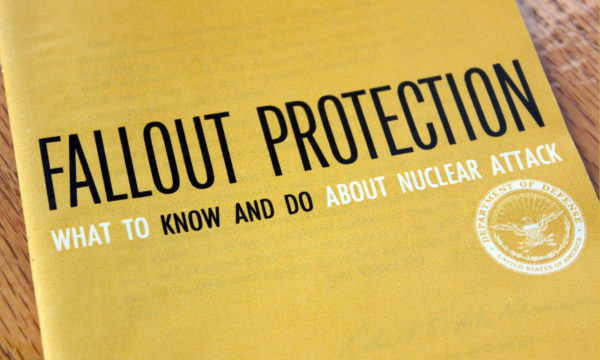
“Fallout protection: What to know and do about nuclear attack,” was a pamphlet created in 1961, intending to spread the word about fallout shelters and radiation protection. Aside from having some pretty interesting graphics (which always brings things to my attention), and being printed in apparently huge numbers, it is notable to me in part because it was one of the few Civil Defense messaging techniques that was actually studied by social scientists at the time, to see how it changed people’s views and understanding on fallout. You can buy well-preserved originals of it on eBay for a song.
Anyway, after various rounds of peer review and discussion, we finally got notice that we were funded, though we had to keep it under wraps until all of the coordination between the foundations was completed. I am pleased to be able to reveal it all now, at long last, and to promise that you will be seeing many interesting things coming out of this work in the near future. And if you know of someone whose work might fit into the category of a good project to fund, please send them the website link and tell them to be in touch (or get in touch yourself, if the person is you) — we are going to try and make the application/funding process as streamlined as possible, with a minimum amount of red tape, if we can.
To explicitly invoke Civil Defense — with full recognition of its controversy, its complications, and its ups and downs — was, as I indicated earlier, a very deliberate move. I’m well aware it is a polarizing subject, and the looks my colleagues and friends have given me when I tell them the name of what we’re working on have been… interesting. But I think that approaching nuclear risk through this lens will be productive and stimulating, and I also think that we live in a time when it is time to re-think, and re-invent, our approaches to these issues. And I’m grateful the funders and our peer reviewers agreed!
I just want to finish this note by thanking my three collaborators (Ed, Julie, Kristyn), the Carnegie Corporation of New York (esp. Carl Robichaud), the members of our all-star Advisory Committee who agreed to have their names attached to such an unusual venture, the N Square Collaborative (esp. Erika Gregory, whose efforts at getting nuclear people to network outside of their normal groups are deeply reflected in the makeup of our Advisory Committee and our approach in general), Alex Glaser at Princeton (whose team also got one of the grants, and who helpfully shared ideas and thoughts with me during the process), and my ever-supportive Dean, Kelland Thomas, who is not just an impressively capable administrator, but has some pretty impressive musical chops.

